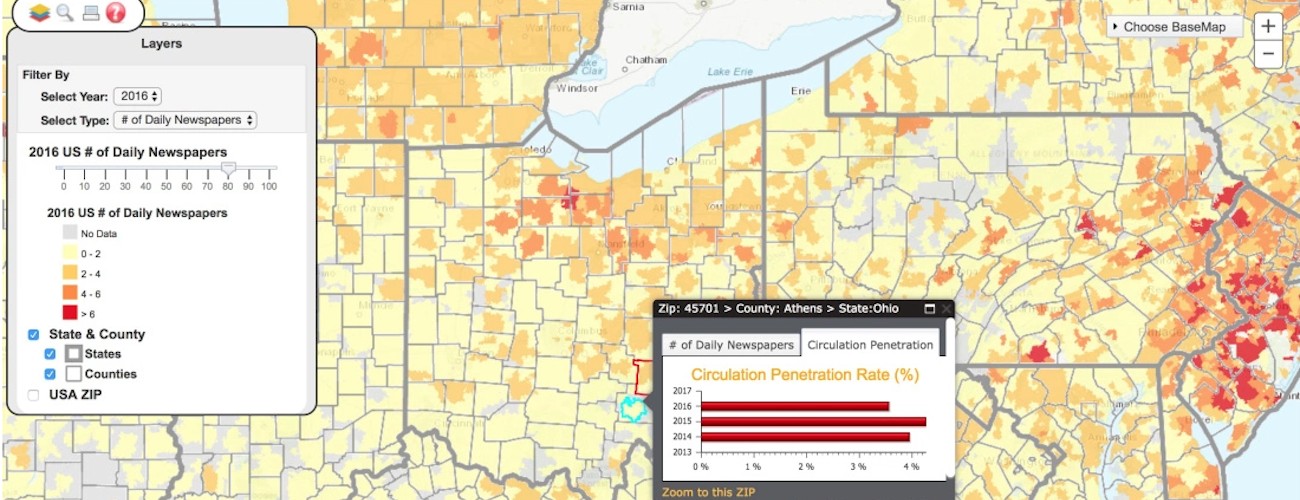Sign up for The Media Today, CJR’s daily newsletter.
The New York Times earlier this year profiled a resident of rural Athens County, Ohio. The editors called him “The Man Who Knew Too Little” because, since November 8, 2016, he had managed to create a bubble around his life into which no external news could enter. Shaken by the election results, he had convinced those around him, including regulars at a local coffee shop, to continue the self-imposed “blockade” as he enjoyed his daily latte in his favorite corner chair. No chit chat with baristas. No news from TV. No news from a newspaper or social media.
I also live in Athens County, Ohio, but our lives couldn’t be more different; you could say I’m jacked into news and information on a cellular level. I teach journalism, social media and online news at the local university. My efforts are largely aimed at getting more, and better, news and information to communities that need it—and to burst the self-imposed bubbles of people who intentionally avoid news and ideas that upsets them. I think that cultivated ignorance and its counterparts—willful sowing of confusion and mistrust via fake news and hyper-partisan propaganda—are destroying our communities. My research and work focus on building our capacity for more and better news and information at the local level.
ICYMI: How do older journalists adapt in an industry that suddenly feels foreign?
One of those efforts is the Media Deserts Project, a research effort that is trying to map the ways in which many of America’s rural communities are indeed impoverished by the lack of fresh, daily local news and information.
As daily newspapers cut and slashed personnel through the Great Recession (or closed completely), they also reduced their coverage of local government and public affairs on their perimeters and in their urban cores. Ownership of local radio stations consolidated in rural areas around right-leaning media organizations with overt political agendas. Broadband access and last-mile challenges in rural communities compounded the issue, making the digital divide as much about geography as it was about income disparities.
The Media Deserts Project is about mapping these changes using geographic information systems down to the ZIP code. The goal is to identify the scope of the problem and, in so doing, help community members and journalism entrepreneurs design localized solutions.
With funding from Duke University and the Democracy Fund, our Media Deserts Research Atlas, launched in March, allows users to search by state, county, and ZIP code to find what daily media are operating there, what formats and platforms are used, and what regulatory conditions might be affecting local access to news.
Just as the Food Access Research Atlas helped drive policy and initiatives to fight hunger in “food deserts,” our goal is to help jumpstart local conversations to fight “news deserts” through local solutions. Others have tried to make the correlation between these growing “news deserts” and effects on democracy. We believe the focus just on news (the content side) masks other dynamics across the local media ecosystem, such as information infrastructure, obstructionist public policy, the availability of non-daily or non-profit sources of local news, and others.
ICYMI: The NYT tweet on books by women that “didn’t play well”
Gathering and processing data for such a project is no simple task. For one layer of our model, we use the Alliance for Audited Media data, specifically for daily newspaper circulation. As others have called out, that dataset is problematic in that not all daily newspapers are audited. We identified other sources of data that allow for deeper analyses. Since 2006, we have been collecting data to fill in the gaps in AAM data from state news organizations, online-only hyperlocal news organizations, broadband accessibility data, and social media analyses at the local level.
Gathering, analyzing, and plotting the data is just the first step. Now we can also start looking for solutions. Since August, students in some advanced journalism courses have monitored more than 20 “media desert” counties in Southeastern Ohio using a variety of tools, from social-media monitoring apps like Hootsuite, Krzana, and NUVI, to personal observations of community behaviors through old-fashioned ethnography. The detailed county-level reports are labor intensive, but they help us fill the gaps in the data and examine the local media ecosystem to determine the individual needs of each community.
So far, students and Media Deserts project leaders have started to build a toolkit to help communities and entrepreneurs develop solutions. Examples include an “information needs audit” (based on the Knight Commission’s model) that determines local access to government records and media sources; a “community dashboard” model that collects the names, address and social media profiles of key local agencies and influencers; a series of “digital ethnographies” using Google Earth’s Street View, through which students narrate a “walkaround” in the community, providing commentary about their observations from both street-level and 10,000-foot views of the geography; and other tools.
The next step, of course, will be to implement solutions. Working in two very rural “news deserts” nearby—Meigs and Morgan counties—students and Media Deserts team leaders are already working with community members to develop solutions that are customized around the unique geographic and cultural aspects of each county.
We probably cannot help people who intentionally choose to live in a news-free bubble, but we certainly can try to help people who are starving for reliable, regular sources of quality local news, especially in communities that for too long have been abandoned or neglected by existing media companies.
ICYMI: NPR deleted a social media post after making an embarrassing mistake
Has America ever needed a media defender more than now? Help us by joining CJR today.



